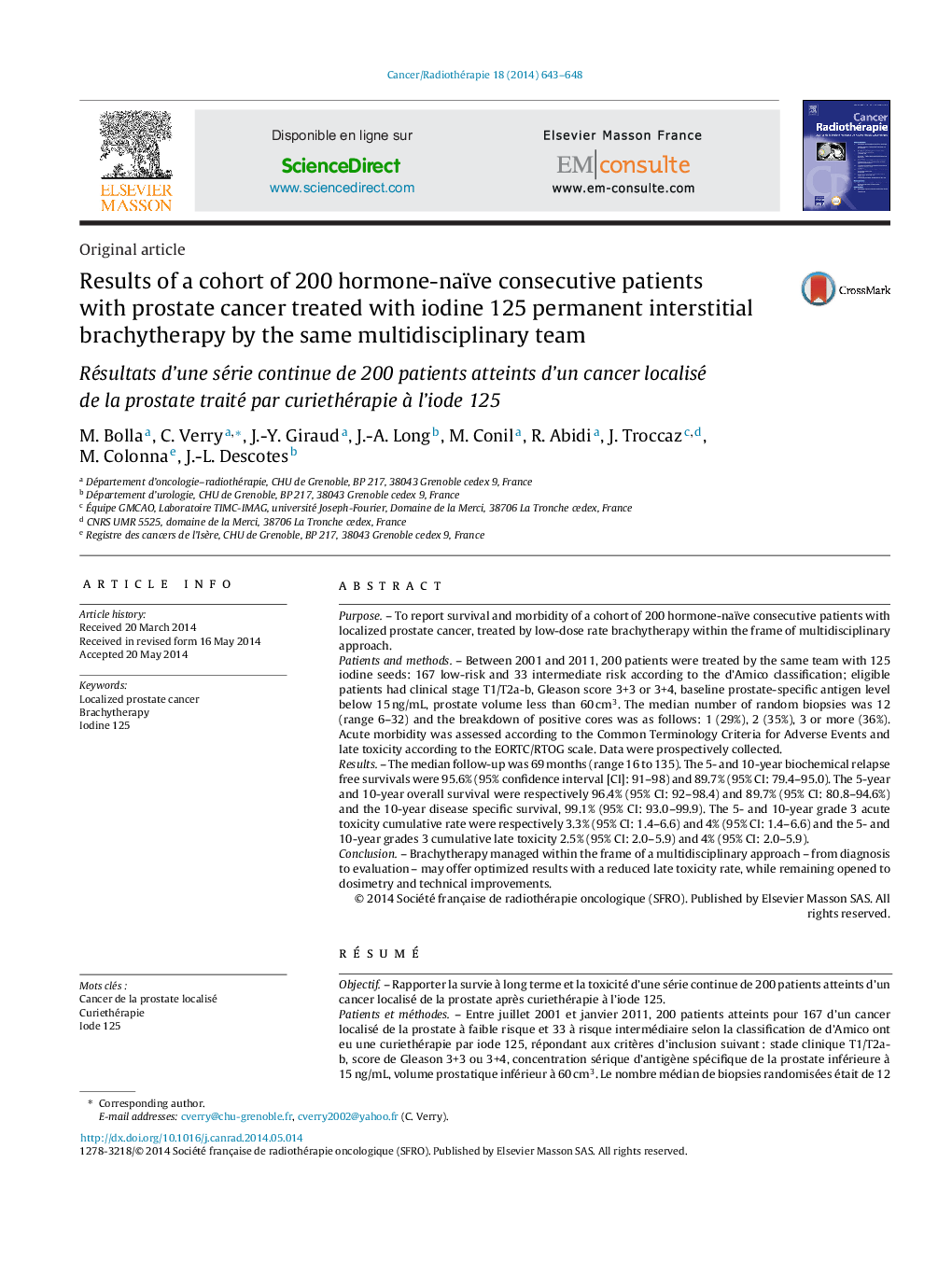| کد مقاله | کد نشریه | سال انتشار | مقاله انگلیسی | نسخه تمام متن |
|---|---|---|---|---|
| 2117786 | 1085212 | 2014 | 6 صفحه PDF | دانلود رایگان |

PurposeTo report survival and morbidity of a cohort of 200 hormone-naïve consecutive patients with localized prostate cancer, treated by low-dose rate brachytherapy within the frame of multidisciplinary approach.Patients and methodsBetween 2001 and 2011, 200 patients were treated by the same team with 125 iodine seeds: 167 low-risk and 33 intermediate risk according to the d’Amico classification; eligible patients had clinical stage T1/T2a-b, Gleason score 3+3 or 3+4, baseline prostate-specific antigen level below 15 ng/mL, prostate volume less than 60 cm3. The median number of random biopsies was 12 (range 6–32) and the breakdown of positive cores was as follows: 1 (29%), 2 (35%), 3 or more (36%). Acute morbidity was assessed according to the Common Terminology Criteria for Adverse Events and late toxicity according to the EORTC/RTOG scale. Data were prospectively collected.ResultsThe median follow-up was 69 months (range 16 to 135). The 5- and 10-year biochemical relapse free survivals were 95.6% (95% confidence interval [CI]: 91–98) and 89.7% (95% CI: 79.4–95.0). The 5-year and 10-year overall survival were respectively 96.4% (95% CI: 92–98.4) and 89.7% (95% CI: 80.8–94.6%) and the 10-year disease specific survival, 99.1% (95% CI: 93.0–99.9). The 5- and 10-year grade 3 acute toxicity cumulative rate were respectively 3.3% (95% CI: 1.4–6.6) and 4% (95% CI: 1.4–6.6) and the 5- and 10-year grades 3 cumulative late toxicity 2.5% (95% CI: 2.0–5.9) and 4% (95% CI: 2.0–5.9).ConclusionBrachytherapy managed within the frame of a multidisciplinary approach – from diagnosis to evaluation – may offer optimized results with a reduced late toxicity rate, while remaining opened to dosimetry and technical improvements.
RésuméObjectifRapporter la survie à long terme et la toxicité d’une série continue de 200 patients atteints d’un cancer localisé de la prostate après curiethérapie à l’iode 125.Patients et méthodesEntre juillet 2001 et janvier 2011, 200 patients atteints pour 167 d’un cancer localisé de la prostate à faible risque et 33 à risque intermédiaire selon la classification de d’Amico ont eu une curiethérapie par iode 125, répondant aux critères d’inclusion suivant : stade clinique T1/T2a-b, score de Gleason 3+3 ou 3+4, concentration sérique d’antigène spécifique de la prostate inférieure à 15 ng/mL, volume prostatique inférieur à 60 cm3. Le nombre médian de biopsies randomisées était de 12 (6–32) et le pourcentage de biopsies positives se répartissait comme suit : 29 % (une biopsie), 35 % (deux biopsies) et 36 % (3 biopsies ou plus). La toxicité aiguë a été évaluée avec l’échelle Common Terminology Criteria for Adverse Events et la toxicité tardive avec l’échelle de l’European Organisation for Research and Treatment of Cancer (EORTC) et du Radiation Therapy Oncology Group (RTOG).RésultatsLe suivi médian était de 69 mois (16 à 135). La probabilité de survie sans récidive biochimique à 5 et 10 ans était respectivement de 95,6 % (intervalle de confiance à 95 % [IC 95 %] : 91 à 98) et 89,7 % (IC 95 % : 79,4 à 95,0) et celle survie globale à 5 ans et 10 ans de 96,4 % (IC 95 % : 92 à 98,4) et 89,7 % (IC 95 % : 80,8 à 94,6 %). L’incidence de toxicité aiguë de grade 3 était : dysurie : 1,5 % ; pollakiurie : 1,6 % ; incontinence : 0,5 % ; rétention urinaire : 1,6 % ; 1,5 % des patients ont souffert d’une toxicité urinaire tardive de grade 3 et 1 % une toxicité digestive tardive de grade 3.ConclusionLa curiethérapie gérée de façon multidisciplinaire du diagnostic à l’évaluation, offre de bons résultats avec un risque de toxicité réduit, laissant la porte ouverte à une optimisation dosimétrique et technique concertée.
Journal: Cancer/Radiothérapie - Volume 18, Issue 7, November 2014, Pages 643–648